
"Climate deniers are using a spell of unusually cold weather in Europe to incorrectly argue that CO2 emissions are not warming the planet."
https://www.dw.com/en/cold-winter-global-warming-polar-vortex/a-56534450
"This is where the disproportionate warming of the Arctic comes into play, said Stefan Rahmstorf, head of the Earth System Analysis research department at the Potsdam Institute for Climate Impact Research (PIK). Temperatures in the Arctic have risen more than twice as fast as the global average over the past 40 years."
metmike:
1. Climate deniers telling people this cold means there is no global warming? I don't know anybody credible that's saying that. However, sources like this one, constantly tell us that everything is caused by global warming...even extreme cold and snow. It's like.........before global warming, those thousands of years with major cold outbreaks and huge Winter storms from natural climate never existed. All extreme weather is now from human caused climate change and none of it would be happening if humans had not increased the global temperature by 1 deg. C. If not for burning fossil fuels, the weather would be almost perfect most of the time (-:
2. Yes, the Arctic has warmed twice as fast as the rest of the planet as they state. Hello! This means that you are equalizing the temperatures (from north to south) across the planet and weakening the temperature gradient. Weakening cold fronts, weakening jet streams. Reducing energy for mid latitude cyclones/storms. Reducing snow. Reducing violent tornadoes. Lessening the need for hurricanes to redistribute heat in the tropics. Creating milder Winters. Warming the coldest places at the coldest times of year the most. Cold still kills 15 times more humans than heat and 200 times more life than heat. This is part of the reason that we are having a climate optimum NOT a climate crisis.
3. Every time the polar vortex has an intrusion very far south now............. according to the climate crisis theory, it's from Arctic warming and climate change. Larry had a good stat on this last week. 5 of the 8 Winters that the Arctic Oscillation dropped to the extremely low values that we just had...............were during 2 decades.......the 1960's and 1970's.......when the planet was experiencing GLOBAL COOLING! Only 2 of the 8 were in recent years, this time makes 3. So, based on this measure, the polar vortex is NOT more likely to drop extremely far south.............during global warming. We are told that but the historical data shows that statement is false. But like every extreme weather event, most of which has happened many times previously/in the past, it gets used to promote the false narratives of a climate crisis.
Blows that theory apart pretty badly.
AO heading for sub -5 on Feb 11th!
7 responses |
Started by WxFollower - Feb. 9, 2021, 9:37 p.m.
https://www.marketforum.com/forum/topic/65465/
- Only 8 winters out of the last 70 have had at least a single day of sub -5 AO:
2010-1 (12/18)
2009-10 (12/20-5, 1/2-6, 2/6-7, 2/14)
1984-5 (1/18-20)
1977-8 (2/5-6)
1976-7 (12/28-9, 1/11-17)
1968-9 (2/13-6)
1965-6 (1/28)
1962-3 (1/21)
metmike: The planet experienced the greatest rate of warming during the 1990's. This REDUCED cold outbreaks, especially the intensity of cold coming from the most extreme Arctic cold.
Time to have some fun busting the junk science:
This is what much of the MSM has been feeding us the last 2 weeks: There was an image of a tv weatherman with a map of the polar vortex, blaming it on global warming below....that’s gone.
Some meteorology 101 for the dude in the picture.
What do you think happens when a natural weather event(Sudden Stratospheric Warming) unrelated to climate change, forces the Polar Vortex to shift very far south, along with the cold air that took months to build in the high latitudes because there was little to no sunshine up there?
All that cold air naturally drains southward to the mid latitudes(USA) and the cold in the north is replaced with air that comes from the mid latitudes, to fill in the air draining south.
This warms up the Arctic/high latitudes as much as it cools down the mid latitudes.
This has been happening for a long time...............before global warming could have ever caused it.
Those are just words, like this guy is using above. Let's show the proof!
Scroll down for later posts!
One of the best tools that we have to measure the intensity of the displacement of the polar vortex is the Arctic Oscillation. We started measuring it in 1950.
Here's a good explanation for the Arctic Oscillation:
https://www.marketforum.com/forum/t
We were discussing it earlier in February here:
5 out of the 8 last times it was this extremely negative was in the 1960's and 1970's............during global cooling.
From WxFollower:
AO heading for sub -5 on Feb 11th!
7 responses |
Started by WxFollower - Feb. 9, 2021, 9:37 p.m.
https://www.marketforum.com/forum/topic/65465/
Only 8 winters out of the last 70 have had at least a single day of sub -5 AO like we witnessed earlier this month:
2010-1 (12/18)
2009-10 (12/20-5, 1/2-6, 2/6-7, 2/14)
1984-5 (1/18-20)
1977-8 (2/5-6)
1976-7 (12/28-9, 1/11-17)
1968-9 (2/13-6)
1965-6 (1/28)
1962-3 (1/21)
The red shades below represent positive AO values. The blue shades represent negative AO values. Think of those blue areas as icicles. The really big ones are often associated with our coldest weather......when cold air in the higher latitudes is flushed south to the middle latitudes.
Note clearly, that the 1950's/60's and 70's featured much more blue icicles......during global cooling. Starting in the 1980's, the reds became dominant in tandem with global warming that has dominated since then. The recent extremely negative Arctic Oscillation that featured the polar vortex in the US is a global cooling pattern. It came in February, after the deadline on this map.
https://www.cpc.ncep.noaa.gov/products/precip/CWlink/daily_ao_index/month_ao_index.shtml

There are numerous examples of a strongly negative Arctic Oscillation happening in the 1950's/60's/70's. Many more times than the last 30 years.
One of the most extreme examples is below, illustrated with the 500 mb map from January 1977.
That Arctic outbreak then was colder than the recent one because the air in the Arctic was MUCH colder in 1977. Freezes were reported all the way to Southern Florida, where they had accumulating snow for the only time in history. The orange crop was obliterated and many trees killed. The brunt of that cold was also aimed slightly farther east of this recent one.
2 billion dollars in today's damages resulted from that cold, just in the state of Florida.
This recent cold event resulted in Dallas dropping to -2 deg. F. That is pretty dang extreme but it's been below 0 in Dallas, 4 other times in history, the most recent was 1989. The all time record cold temperature for Dallas is -8 deg. F, set way back in 1899.......before global warming started.
This pattern below from January 1977 was very similar to February 2021. Except the Arctic was COLDER then and aimed slightly farther east, so the Arctic air mass that came in was COLDER in January 1977.

Here's some damage control from the NYT's this morning, claiming that TX was not ready for climate change and thats why they were hit so hard.
It's the POLAR opposite. TX was hit so hard BECAUSE they were preparing for climate change.
 | By David Leonhardt |
| Good morning. We look at Texas’ big economic strengths — and a threat to its future. |
|
‘Texas can be the future’ |
| You can make a case that the U.S. state with the brightest long-term economic future is Texas. |
| It’s a more affordable place to live than much of the Northeast or West Coast and still has powerful ways to draw new residents, including a thriving cultural scene, a diverse population and top research universities. Its elementary schools and middle schools perform well above average in reading and math (and notably ahead of California’s), according to the Urban Institute. |
| These strengths have helped the population of Texas to surge by more than 15 percent, or about four million people, over the past decade. In the past few months, two high-profile technology companies — Oracleand Hewlett-Packard Enterprise — have announced they are moving their headquarters to the state, and Teslamay soon follow. As California was in the 20th century, Texas today looks like a state that can embody and shape the country’s future. |
| But Texas also has a big problem, as the world has just witnessed. A useful way to think of it is the fossil fuel problem. |
‘This’ll happen again’ |
| Even with its growing tech and health care industries, the Texas economy revolves around oil and gas. And those fossil fuels have created two threats to the state’s economic future. |
| The first is climate change, which is making Texas a less pleasant place to live. The number of 95-degree days has spiked, and severe hurricanes have become more common, including Harvey, which brutalized Houston and the Gulf Coast in 2017. Paradoxically, climate change may also be weakening the jet stream, making bouts of frigid weather more common. |
| On the national level, Texas politicians have playeda central
rolein preventing action to slow climate change. On the local level, leaders have failed to prepare for the new era of extreme weather — including leaving the electricity grid vulnerable to last week’s cold spell, which in turn left millions of Texans without power and water. |
| Many residents feel abandoned. In Copperas Cove, a city in central Texas, Daniel Peterson told my colleague Jack Healy on Saturday that he was utterly exasperated with the officials who had failed to restore power six days after it went out. He is planning to install a wood-burning stove, because, as he said, “This’ll happen again.” |
| In Dallas, Tumaini Criss spent the weekend worried that she would not be able to afford a new home for her and her three sons after a leaky pipe caved in her ceiling and destroyed appliances and furniture. “I don’t know where that leaves me,” she said. |
| In San Antonio, Juan Flores, a 73-year-old Navy veteran, told my colleague Giulia McDonnell Nieto del Rio that he was frustrated by the lack of communication from local officials. When Giulia interviewed Flores, he had not showered in days (and graciously warned her to stand back while interviewing him, saying, “I stink”). To get enough water to flush his toilet, he had walked to a bar. To heat his apartment, he was boiling water on his stove. |
| The second threat is related to climate change but different. It comes from the possibility that alternative energy sources like wind and solar power are becoming cheap enough to shrink Texas’ oil and gas industry. |
| “The cost advantage of solar and wind has become decisive, and promises to become vaster still,” Noah Smith, an economist and Texas native, wrote in his Substack newsletter. “I don’t want to see my home state become an economic backwater, shackled to the corpse of a dying fossil fuel age.” |
| Instead of investing adequately in new energy forms, though, many Texas politicians have tried to protect fossil fuels. Last week, Gov. Greg Abbott went so far as to blame wind and solar energy — falsely— for causing the blackouts. The main culprit was the failure of natural gas, as these charts by my colleague Veronica Penney show. |
| As Smith explains, the best hope for Texas’ energy industry is probably to embrace wind and solar power, not to scapegoat them. The state, after all, gets plenty of wind and sun. “Texas can be the future, instead of fighting the future,” Smith wrote. |
| The larger economic story here is a common one. Companies — and places — that have succeeded for decades with one technology rarely welcome change. Kodakdidn’t encourage digital photography, and neither The New York Times nor The Wall Street Journal created Craigslist. |
| Texas’ political and business leaders have made a lot of successful moves in recent decades. They have avoided some of the political sclerosis that has held back parts of the Northeast and California, like zoning restrictions that benefit aging homeowners at the expense of young families. |
| But Texas’ leaders are sacrificing the future for the present in a different way. They have helped their fossil fuel companies maximize short-term profits at the expense of the state’s long-term well-being. They have resisted regulation and investments that could have made their power grid more resilient to severe weather (as this Times story documents), and have tried to wish away climate change even as it forces Texans to endure more miserable weather. |
| In those ways, Texas is offering a different — and more worrisome — glimpse into the future. |
TX was hit so hard BECAUSE they were preparing for climate change.....not because they were NOT prepared for climate change.
17% of the power now comes from wind.
Edit, 3-1-21: Apparently they relied on up to 30% of power generation from wind just prior to this event and during the bitter cold with wind turbines not Winterized, that plunged to 8%.
By far, the most of any state. They did not Winterize the wind turbines or natural gas/fossil fuel systems BECAUSE they thought cold like this was not possible anymore with global warming. The wind turbines could have been Winterized and we would have avoided the worst of this but the green energy mentality that ignores the fact that cold kills 15 times more humans than heat and 200 times more life than heat is what led to this. And the assumption that we couldn't have cold like this anymore because of all the exaggerated forecasts for warmth.
https://howmuch.net/articles/wind-power-in-the-united-states-2018

https://en.wikipedia.org/wiki/Wind_power_in_Texas
 | Wind power in Texas - Wikipedia en.wikipedia.org |
Even with all of the system-wide failures, natural gas is the only reason that this energy disaster didn’t claim hundreds, if not thousands, of lives. Winter Storm Younger Dryas will probably surpass Hurricane Harvey as the most expensive natural disaster in Texas history and ERCOT was possibly within five minutes of it being possibly the most expensive natural disaster in U.S. history when they began load-shedding.
·
"The infrastructure failures in Texas are quite literally what happens when you *don’t* pursue a Green New Deal."
metmike: 100% exactly wrong. Texas did not get caught because they were not ready for climate change(the coming fake crisis). They got caught BECAUSE they were preparing for the fake climate crisis.
For one time, why can't this lady tell the truth??
This is the indisputable proof.:

In February 2021, prior to Winter Storm Younger Dryas, wind accounted for 30% of ERCOT’s electricity generation…
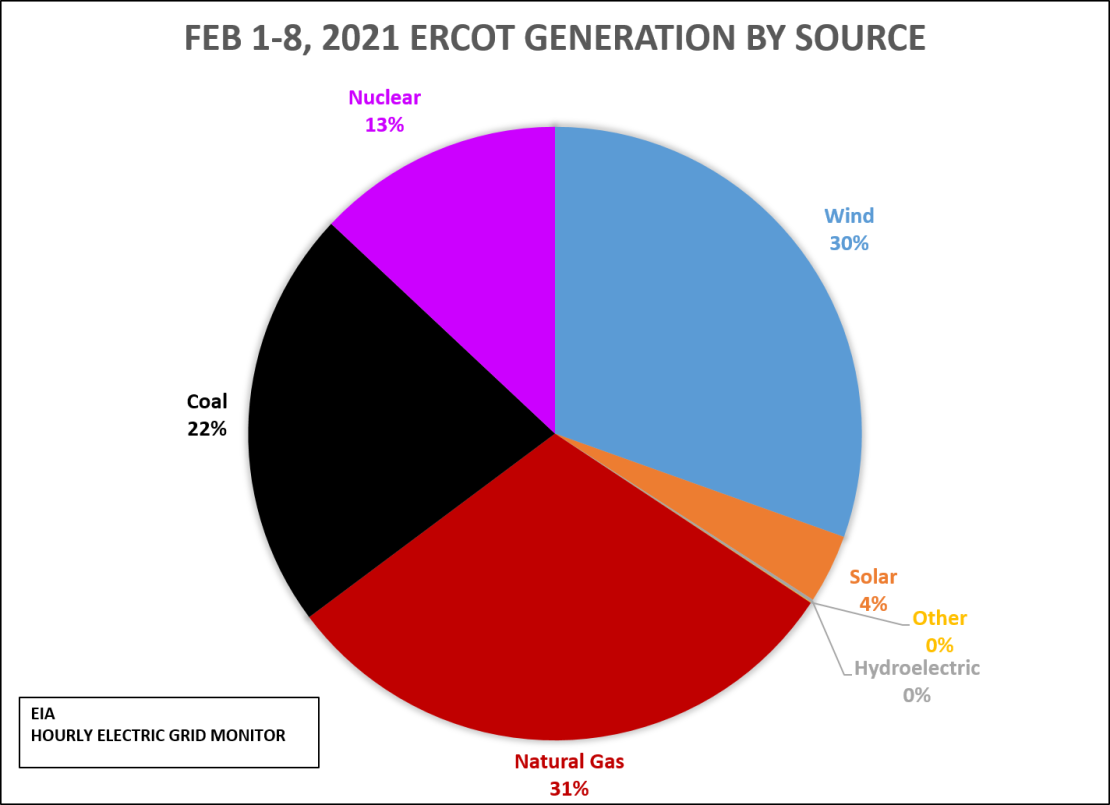
During Winter Storm Younger Dryas, wind dropped off to 8% of ERCOT electricity generation, while natural gas more than doubled as a percentage of ERCOT electricity generation…
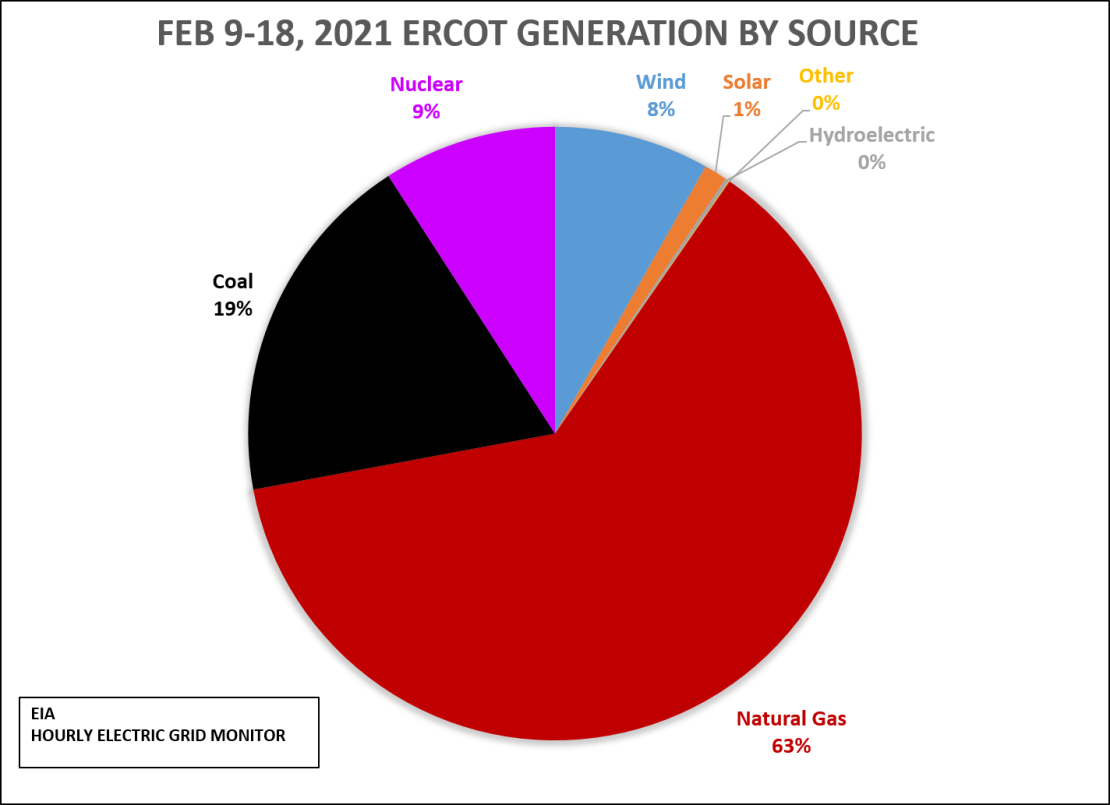
Why was Texas, ERCOT (Electric Reliability Council of Texas) in particular, so unprepared for the onslaught of frigid weather? This was NOAA’s February temperature outlook map, released on January 31, 2021:

20 days later, this was NOAA’s map of the number of hours below freezing for the week of Feb. 12-19, 2021:

In less than a week, we went from an outlook for about normal February temperatures to the forecast of an ice storm and then “the worst winter weather conditions seen locally in decades (if not on record)”… Radical would be an understatement.
february 8, 2021 weather
29 responses |
Started by metmike - Feb. 8, 2021, 1:50 p.m.
https://www.marketforum.com/forum/topic/65392/
Fantastic February to you!
Coldest blast in a couple of years on the way! numerous snow/ice events along the ohio river the next 10 days!
edit: Coldest in decades for TX with snow/ice!
moderation expected late february is helping drive ng prices(lower)....containing the bulls....today at least.
Reasons to continue to keep being thankful here in 2021!
https://www.marketforum.com/forum/topic/45623/
NEW: COVID peaked a month ago!
https://www.marketforum.com/forum/topic/63690/
Scroll down and enjoy the latest comprehensive weather to the max...... occurring because of the natural physical laws in our atmosphere as life on this greening planet continues to enjoy the best weather/climate in at least 1,000 years(the last time that it was this warm) with the added bonus of extra beneficial CO2.
Most maps below will automatically update each day(not the snow map).
the maps below do not show the areas of ice that WILL fall, just south of the heavier snow!
Total Snow for the next 1 week and 2 weeks from the 12z Monday GFS Ensemble model.
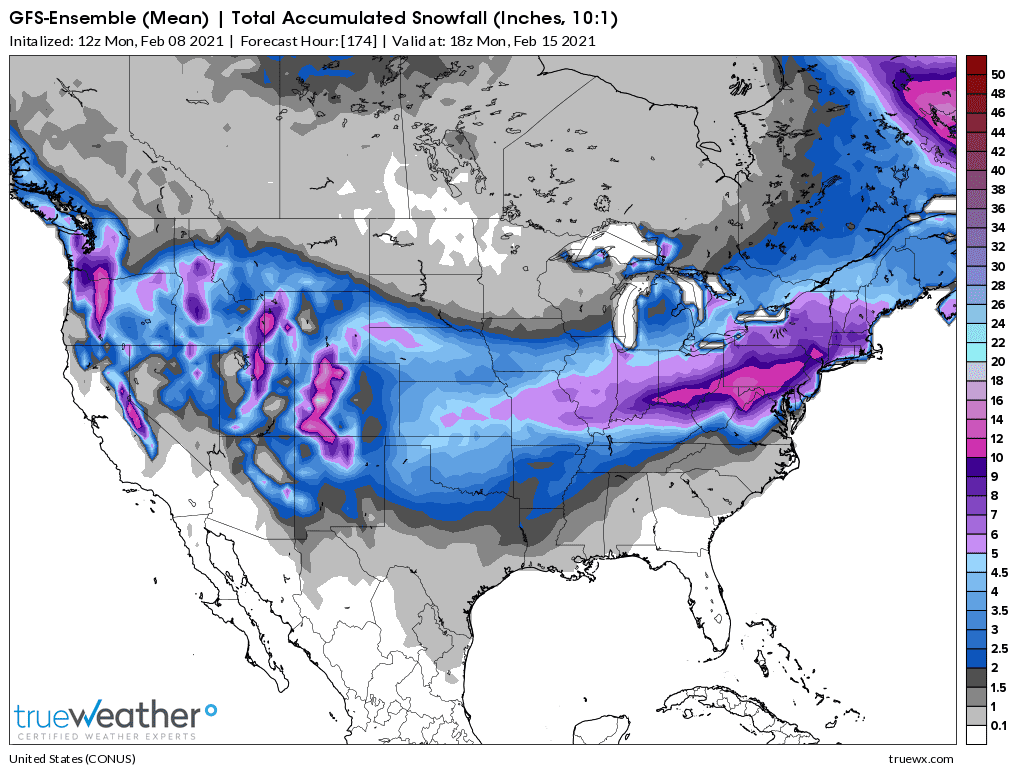
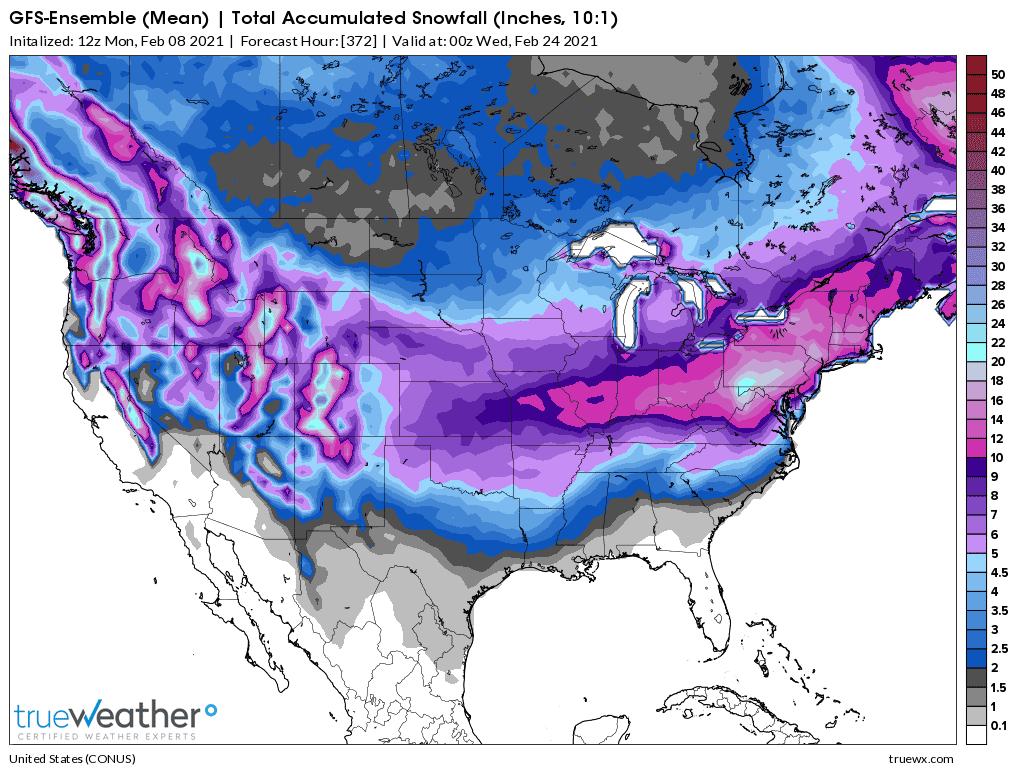
++++++++++++++++++++++++++++++++++++++++++++++++++++++++++++++++++++++++++++++
https://www.marketforum.com/forum/topic/65639/
February 14, weather
18 responses |
Started by metmike - Feb. 14, 2021, 1:07 p.m.
Happy Valentines Day!
Roses are Red, Violets are Blue..............here is your Wild Winter Weather Review!
Coldest blast in years for some places. 2 main snow/ice events this week.
Edit: Coldest in decades for TX with snow/ice!
Moderation expected late February ........containing the natural gas bulls today.
Reasons to continue to keep being thankful here in 2021!
https://www.marketforum.com/forum/topic/45623/
COVID peaked over a month ago!
https://www.marketforum.com/forum/topic/63690/
Scroll down and enjoy the latest comprehensive weather to the max...... occurring because of the natural physical laws in our atmosphere as life on this greening planet continues to enjoy the best weather/climate in at least 1,000 years(the last time that it was this warm) with the added bonus of extra beneficial CO2.
Most maps below will automatically update each day(not the snow map).
the maps below do not show the areas of ice that WILL fall, just south of the heavier snow!
Total Snow for this week from the 12z Sunday GFS Ensemble model.
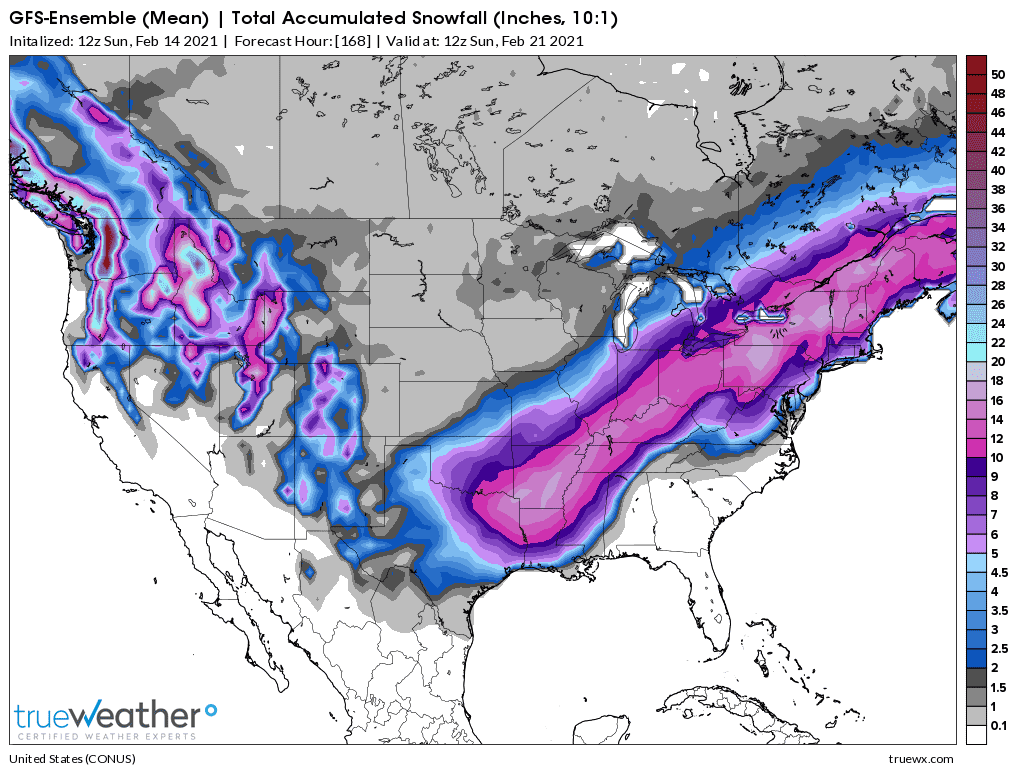
https://www.insider.com/texas-warned-to-winterize-power-plants-after-past-cold-events-2021-2
By Chris Martz on • ( 6 )
“By failing to prepare, you are preparing to fail.”
— Benjamin Franklin

+++++++++++++++++++++++++++++++++++++++++++++++++++++++++++++++++++++++++++++
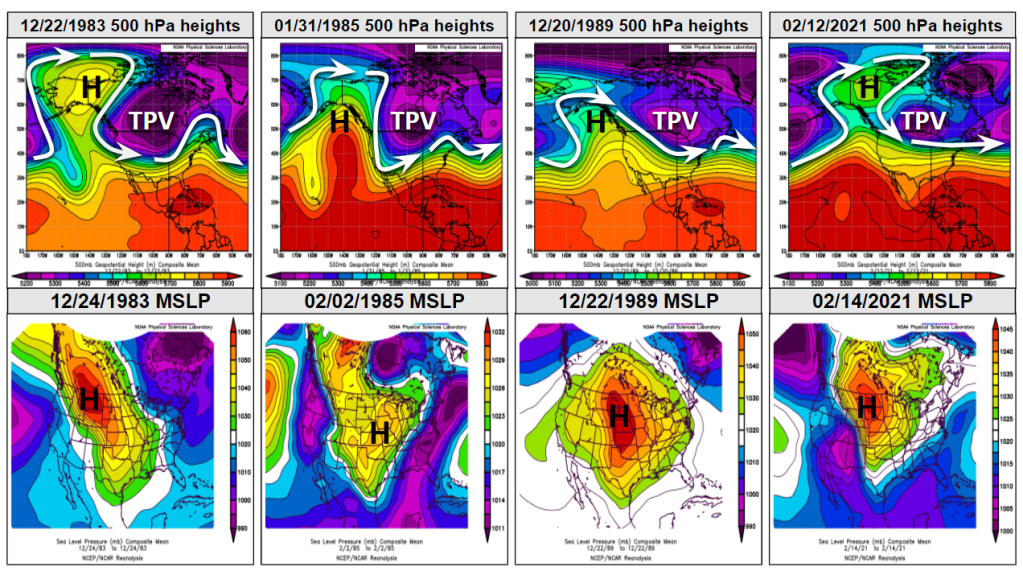
Figure 7. Southern plains cold air outbreak evolution. Top panel is of 500 mb heights over North America in the days leading up to the event, while the bottom panel shows surface mean sea-level air pressure (MSLP) during the coldest day of the outbreak – Maps from NOAA PSL.
+++++++++++++++++++++++++++++++++++++++++++++++++++++++++++++++++++++
 Figure 12. Average number of November-March cold waves (2+ days per station) colder than the 5th percentile of daily January maximum temperatures – Dr. John Christy, UAH.
Figure 12. Average number of November-March cold waves (2+ days per station) colder than the 5th percentile of daily January maximum temperatures – Dr. John Christy, UAH.
Furthermore, the total number of daily record low minimum temperatures tallied up from 805 United States Historical Climatology Network (USHCN) stations has taken a rather steep decline since the mid-1980s (Figure 13).¹⁷ There was a similarly low period between the mid-1930s and early-1950s, but thanks to both urbanization locally and the lesser amount of cold air to work with in the Arctic, the current low period is quite a bit lower than that observed several decades ago.
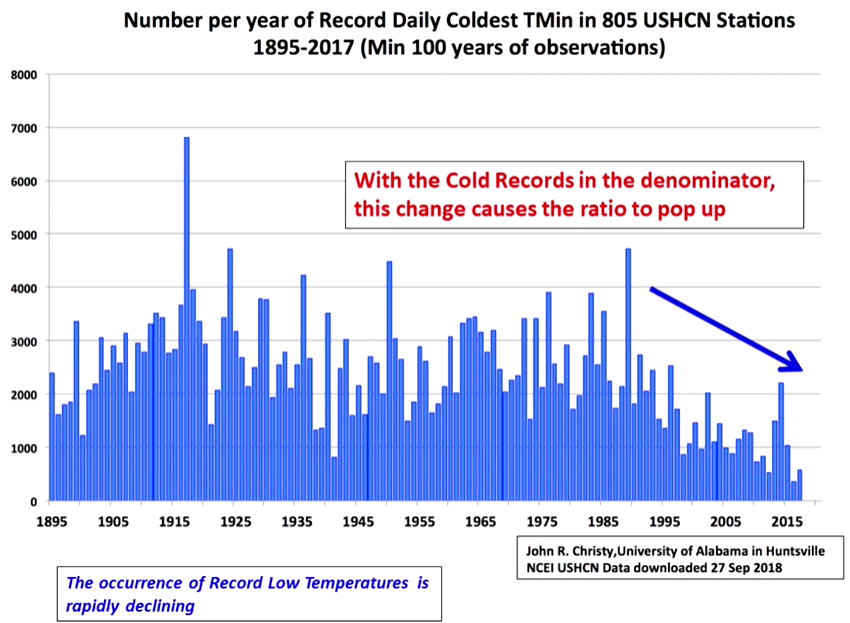
If the two graphs already shown aren’t compelling enough, well, here’s a graph from the Environmental Protection Agency (EPA) of the percent of land area in the Continental United States by year experiencing unusually cold wintertime temperatures from 1911 to 2016 (Figure 14).¹⁸ While the graph is a bit dated, as government agencies seemingly never like to update anything, the long-term downward trend in land area affected is without a doubt unaffected by anything that has occurred within the last five years. The biggest exceptions to recently mild conditions were in 2009-10, 2010-11, 2013-14, and in 2014-15.

Global warming theory specifically states that as the planet warms, latitudinal thermal gradients between the Arctic and mid-latitudes weaken as the Arctic warms at a faster rate due to sea ice loss that initiates a positive feedback loop. This is where applying global warming theory is correct. However, the reduction in thermal gradients corresponds to lower amounts of baroclinic instability. Why is this important? Well, baroclinic instability is necessary for initiating extratropical cyclone development (Dacre et al. 2012 and references therein), which in fact causes a reduction in atmospheric thickness values between 500 hPa and 1000 hPa by means of cold air advection from the north and west, causing the upper level trough to deepen and elongate as shown in Figure 15 below.¹⁹ A lack of baroclinicity in a warmer climate inhibits planetary waves from elongating, exactly opposite of what is claimed by the press and even some scientists such as Dr. Jennifer Francis, as discussed in Blackport and Screen (2020).²⁰
Who remembers when Obama marched out his climate czar, John Holdren to do damage control when the polar vortex made a natural excursion south back in 2014 to tell us global warming caused extreme cold?
And the MSM was so excited to have one of their climate religion high priests coming out to assure them that everything was still just fine. They could still keep believing in the the fake climate crisis.
https://www.motherjones.com/politics/2014/01/john-holdren-video-polar-vortex/
“A growing body of evidence suggests that the kind of extreme cold being experienced by much of the United States as we speak is a pattern that we can expect to see with increasing frequency as global warming continues,”
Just another, of many hundreds of examples over the past 2+ decades of extreme weather being blamed on climate change.
It's as if we never had extreme weather on the planet before CLIMATE CHANGE and accelerating global warming is causing all of it now.
Latest global temperature was -0.01 vs the 30 year average. Yeah, that some extreme, accelerating warming alright(-:
https://www.marketforum.com/forum/topic/68079/#68304
March Global Temperature -0.01 deg. C vs 30 year average
Started by metmike - April 3, 2021, 1:29 p.m.
I need to continue to make it clear that I'm a practicing environmentalist who cares deeply about the planet who has dedicated his life to making the world a better place.
Please do not believe any propaganda that tries to convince targets of the false narratives, that people like me are trying to sabotage their effort to save the planet.
Being a good steward of the planet should be a top priority for everybody, no matter what your political affiliation is........based entirely on objective, authentic science and the truth.
Please join me in that effort.
The real environmental crisis's/insects dying-dead zones-aquifers drying up-plastics in the ocean-landfills/trash-over consumption of natural resources(metmike is a PRACTICING environmentalist): April 2019
UAH Global Temperature Update for April 2021: -0.05 deg. C
Started by metmike - May 3, 2021, 12:11 a.m.
https://www.marketforum.com/forum/topic/68838/
metmike: As one can readily see, since we have been having some modest global cooling, the extreme cold events being blamed on accelerating global warming make no sense.
Extreme global warming enthusiasts/believers. Please look at the graph above, which is an actual measurement of the temperatures on the planet and try to see why global warming would NOT explain the dozens of unusually cold weather events around the Northern Hemisphere this past Winter and Spring.